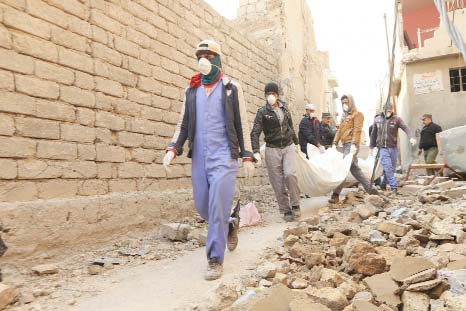
Reuters, Mosul :
The Iraqis who have come home to Mosul’s Old City knew it would be hard living in the rubble left by the battle against Islamic State, but there is one aspect of their surroundings they are finding unbearable seven months on.
“I don’t want my children to have to walk past dead bodies in the street every day,” said Abdelrazaq Abdullah, back with his wife and three children in the quarter where the militants made their last stand in July against Iraqi and U.S.-led coalition forces.
“We can live without electricity, but we need the government to clear the corpses – they’re spreading disease and reminding us of the horrors we’ve just lived through.” The stench of death wafts from rubble-filled corners in the dystopian wasteland of what was once West Mosul, from rusting cars still rigged with explosives and from homes abandoned as those who could, fled the bloody end of the militants three-year rule.
The corpses lying in the open on many streets are mainly militants from the extremist Sunni group who retreated to the densely-packed buildings of the Old City, where only the most desperate 5,000 of a pre-war population of 200,000 have so far returned.
Local residents and officials in predominantly Sunni Mosul say there are also thousands of civilian bodies yet to be retrieved from the ruins, a view which has put them at odds with the Shi’ite-led government in Baghdad.
“There are no more civilian bodies to be picked up in Mosul,” said Brig Gen Mohammad Mahmoud, the head of Mosul’s Civil Defence, first responders who report to the Interior Ministry and are tasked with collecting them and issuing death certificates. The Civil Defence says it had collected 2,585 civilian bodies by mid-January – many of them still unidentified – and has completed operations. It does not want to waste resources on the militants.
The Iraqis who have come home to Mosul’s Old City knew it would be hard living in the rubble left by the battle against Islamic State, but there is one aspect of their surroundings they are finding unbearable seven months on.
“I don’t want my children to have to walk past dead bodies in the street every day,” said Abdelrazaq Abdullah, back with his wife and three children in the quarter where the militants made their last stand in July against Iraqi and U.S.-led coalition forces.
“We can live without electricity, but we need the government to clear the corpses – they’re spreading disease and reminding us of the horrors we’ve just lived through.” The stench of death wafts from rubble-filled corners in the dystopian wasteland of what was once West Mosul, from rusting cars still rigged with explosives and from homes abandoned as those who could, fled the bloody end of the militants three-year rule.
The corpses lying in the open on many streets are mainly militants from the extremist Sunni group who retreated to the densely-packed buildings of the Old City, where only the most desperate 5,000 of a pre-war population of 200,000 have so far returned.
Local residents and officials in predominantly Sunni Mosul say there are also thousands of civilian bodies yet to be retrieved from the ruins, a view which has put them at odds with the Shi’ite-led government in Baghdad.
“There are no more civilian bodies to be picked up in Mosul,” said Brig Gen Mohammad Mahmoud, the head of Mosul’s Civil Defence, first responders who report to the Interior Ministry and are tasked with collecting them and issuing death certificates. The Civil Defence says it had collected 2,585 civilian bodies by mid-January – many of them still unidentified – and has completed operations. It does not want to waste resources on the militants.

